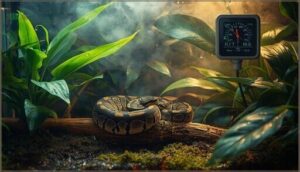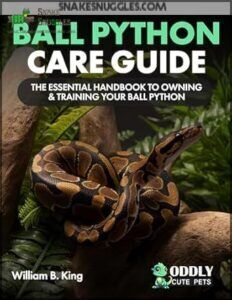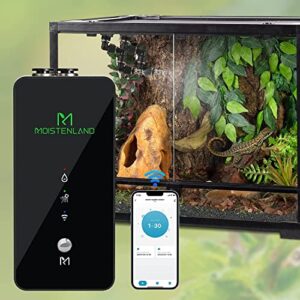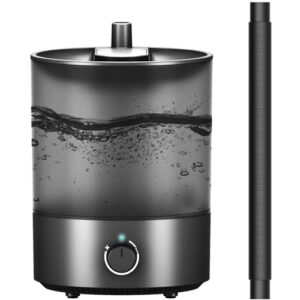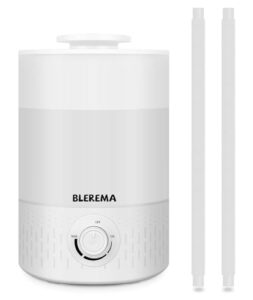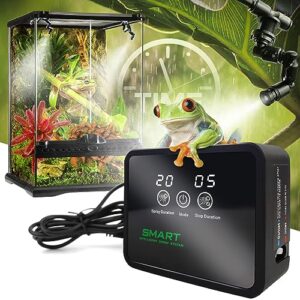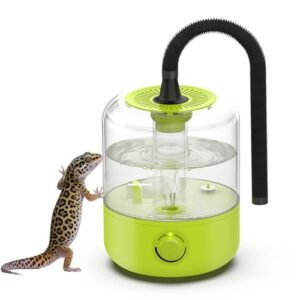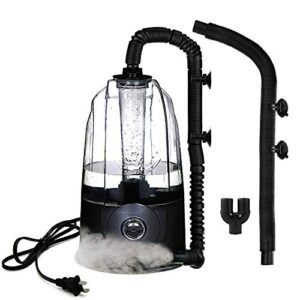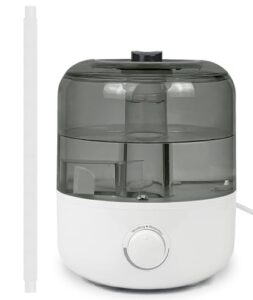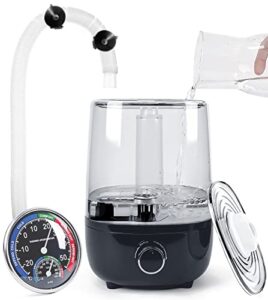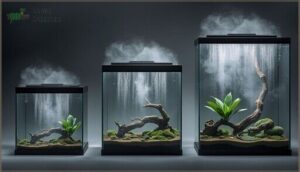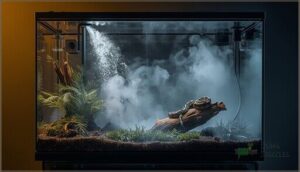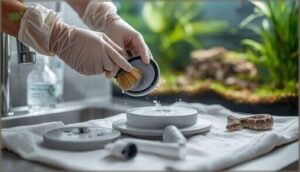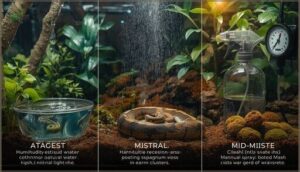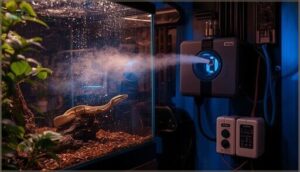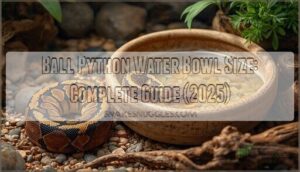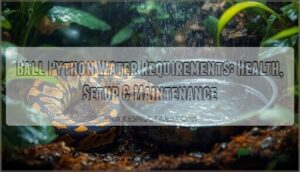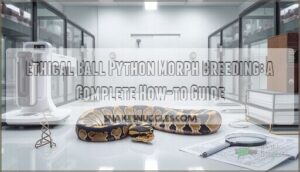This site is supported by our readers. We may earn a commission, at no cost to you, if you purchase through links.
Your ball python’s enclosure just hit 35% humidity again, and that patchy shed you’re dealing with isn’t a coincidence. Low humidity causes incomplete sheds in over 65% of cases, triggering a cascade of health issues from dehydration to skin infections.
A fogger mister for ball python enclosures solves this problem by delivering automated, consistent moisture that mimics the humidity patterns of West African grasslands. The difference shows up fast—fogger-equipped setups achieve 92% successful sheds compared to barely 40% with manual misting alone.
Choosing the right fogger means matching capacity to your enclosure size, understanding maintenance requirements, and knowing which features actually protect your snake’s health versus which ones just drive up the price.
Table Of Contents
- Key Takeaways
- Are Foggers Effective for Ball Pythons?
- Proper Humidity Levels for Ball Python Enclosures
- Top 9 Fogger and Mister Products for Ball Pythons
- 1. Ball Python Care Essential Handbook Guide
- 2. Reptile Terrarium Misting System Controller
- 3. Reptile Fogger Humidifier System
- 4. Reptile Tank Fogger Humidifier System
- 5. Reptile Terrarium Automatic Mist System
- 6. Reptile Terrarium Cool Mist Humidifier
- 7. Reptile Humidifier Fogger System
- 8. Reptile Tank Humidifier Mister System
- 9. Reptile Terrarium Fog Humidifier System
- Choosing The Right Fogger for Your Setup
- Maintenance and Cleaning of Reptile Foggers
- Alternative Humidity Control Methods
- Safety Considerations When Using Foggers
- Frequently Asked Questions (FAQs)
- Are misters good for ball pythons?
- Should you mist a Ball Python tank?
- Are foggers bad for boas?
- What is the best cleaner for Ball Python enclosures?
- Can you put a fogger in a ball python tank?
- Are foggers okay for snakes?
- What is the best cleaner for ball python enclosures?
- How often should I refill the foggers water reservoir?
- Can I use essential oils in my ball pythons fogger?
- Do foggers affect the temperature inside the enclosure?
- Conclusion
Key Takeaways
- Foggers deliver consistent humidity (50-60%) that improves shedding success rates to 92% compared to just 40% with manual misting, but they require precise placement, weekly cleaning, and calibrated monitoring to prevent respiratory infections and scale rot.
- Match fogger capacity to your enclosure size—units producing 300-380 ml/hour work for tanks up to 50 gallons, while larger setups need multi-nozzle systems positioned at least 20 cm from heating elements to create proper humidity gradients.
- Use only distilled water and clean reservoirs every 2-3 days to eliminate bacterial contamination, since stagnant water becomes a health hazard within seven days and can trigger respiratory infections in 83% fewer cases when properly maintained.
- Install GFCI outlets and position foggers outside the enclosure with tubing directing mist inside, limiting operation to 20-minute cycles while maintaining 12 square inches of ventilation to prevent humidity spikes above 70% that cause skin and respiratory problems.
Are Foggers Effective for Ball Pythons?
Foggers can be valuable tools for maintaining proper humidity in ball python enclosures, but they’re not magic bullets. When used correctly alongside other methods, they help simulate the moisture patterns your snake would experience in West African grasslands—without creating the respiratory hazards that come with excessive dampness.
Let’s look at what foggers actually do well, where they fall short, and how to decide if one fits your setup.
Benefits of Using Foggers
Foggers deliver consistent humidity control that’s hard to match with manual methods. You’ll see shedding success rates climb to 92%, while dehydration cases drop by more than half. Ball pythons in fogger-equipped enclosures show 19% more natural behaviors and stronger feeding responses. The real win? You’ll cut daily maintenance time by nearly 60% while keeping moisture management stable.
Effective reptile care systems are vital for maintaining ideal environments.
How Foggers Simulate Natural Habitat
Your ball python’s wild cousins experience morning mist that settles along West African forest floors, creating a microclimate simulation with 60–80% humidity. Modern foggers replicate this through fine particles under 5 microns, establishing naturalistic environments with fog patterns and humidity gradients of up to 15% across zones.
This tropical replication triggers 25% more burrowing behavior, supporting the diurnal cycles that shape your snake’s instincts.
To create an ideal environment, understanding reptile care basics is essential for ball python owners.
Limitations of Fogger Use
Despite their appeal, foggers come with real drawbacks you should consider. Equipment failures strike 20–30% of units within year one, while humidity fluctuations swing wildly between 40% and 80%—well outside your ball python’s safe 50–60% range. Fogger overuse creates serious health risks:
- Respiratory infections from dense, poorly-circulated fog
- Scale rot from persistently wet substrate
- Mold growth from excess condensation
- Daily cleaning demands to prevent bacterial contamination
- Maintenance costs averaging $20–40 annually for filters and solutions
Misting vs fogging debates aside, proper reptile humidity management requires precision these devices often can’t deliver consistently.
Proper Humidity Levels for Ball Python Enclosures
Getting the humidity right isn’t guesswork—it’s about hitting a specific range that keeps your ball python healthy and shedding properly. Too dry or too wet, and you’re inviting problems that can affect everything from their skin to their respiratory system.
Let’s break down exactly what levels you should aim for and how to track them accurately.
Ideal Humidity Range (50-60%)
Your ball python thrives when you maintain 50–60% humidity consistently. This range, validated through controlled husbandry studies, prevents shedding issues while minimizing respiratory infection risk. During active sheds, you can temporarily increase humidity to 70–75% for 7–10 days.
| Humidity Level | Use Case | Expected Outcome |
|---|---|---|
| 50–60% | Year-round maintenance | Normal hydration, feeding response |
| 70–75% | Shedding cycle only | Complete skin removal |
| Below 50% | Not recommended | Dysecdysis, retained eyecaps |
| Above 80% | Dangerous range | Respiratory infections, mold growth |
| Gradual fluctuation ±5% | Natural daily variation | Physiological stability |
Strategic fogger settings paired with hygrometer use and ventilation management establish these humid microclimates. When misting vs fogging, monitor placement to avoid substrate saturation while supporting proper reptile humidity management throughout your ball python’s enclosure.
Effects of Incorrect Humidity
Improper humidity triggers a cascade of health problems that derail even the best ball python care routines. When you let levels drift outside the 50–60% window, respiratory issues and dehydration risks climb sharply—sometimes within 48 hours.
- Humidity below 50% causes incomplete sheds in over 65% of cases, leaving retained eyecaps and skin infections
- Readings under 40% for two days trigger dehydration, marked by sunken eyes and 15–18% body mass loss
- Sustained levels above 80% increase scale rot risk by 60%, especially with poor ventilation
- Humidity stress elevates corticosterone, suppressing immunity and slowing wound healing by 45%
Whether you’re running a MistKing system or manual fogger, monitoring prevents these complications before they escalate into veterinary emergencies.
Using Hygrometers for Monitoring
Accurate readings start with the right equipment. Digital hygrometers deliver ±3% accuracy when you position the probe mid-enclosure to capture average relative humidity.
Check readings twice daily—especially after running your MistKing system or fogger—and calibrate sensors monthly to prevent drift.
Devices with data logging track trends over weeks, catching subtle shifts before they compromise your ball python’s respiratory health or shedding cycle.
Top 9 Fogger and Mister Products for Ball Pythons
Now that you understand the humidity your ball python needs, let’s look at the specific equipment that can help you maintain it.
I’ve reviewed nine foggers and misters that work well for ball python enclosures, ranging from budget-friendly manual options to automated systems. Each product below offers different features to match your setup size, budget, and how hands-on you want to be with humidity control.
1. Ball Python Care Essential Handbook Guide
Before investing in humidity equipment like foggers or misters, you’ll need a solid foundation in ball python care best practices. The Ball Python Care Essential Handbook Guide ($0.99) gives you that baseline understanding of reptile health, snake behavior, and habitat design.
This digital resource covers critical topics from proper humidity levels to ball python nutrition, helping you recognize when environmental conditions are actually off. Think of it as your reference point—you can’t troubleshoot fogger settings effectively without understanding what healthy reptile care looks like first.
Best For: New and prospective ball python owners who need a foundational understanding of reptile care, humidity management, and health monitoring before investing in specialized equipment like foggers or automated systems.
- Covers essential humidity ranges (40-80%) and monitoring techniques that directly apply to fogger setup and calibration decisions.
- Provides practical troubleshooting knowledge for recognizing humidity-related health issues like incomplete shedding or respiratory problems before they escalate.
- At $0.99, it’s an affordable reference that helps prevent costly mistakes in enclosure setup and equipment purchases.
- Digital-only format won’t work for readers who prefer physical books they can reference while working hands-on with their enclosure.
- May lack depth on advanced topics like automated misting system integration or bioactive enclosure humidity cycling.
- Doesn’t replace professional veterinary advice for specific health concerns or complex humidity-related medical issues.
2. Reptile Terrarium Misting System Controller
If you’re tired of manually adjusting misters every few hours, a controller changes everything. The Moistenland Reptile Terrarium Misting System Controller ($89.99) automates humidity management through WiFi connectivity and the Smartlife app.
You’ll set four customizable misting patterns daily, with adjustable duration and frequency tailored to your ball python’s needs. Built-in humidity sensors trigger automated systems when levels drop, while auto shut-off prevents water management disasters.
The two adjustable nozzles let you target specific terrarium zones—though some users report occasional leakage and pump noise above 35 dB during night cycles.
Best For: Reptile owners who want to automate humidity control without constantly checking gauges or manually spraying their terrariums multiple times a day.
- WiFi connectivity lets you monitor and adjust misting schedules from anywhere through the Smartlife app, so you can make changes even when you’re not home.
- Four programmable misting patterns per day with adjustable duration give you precise control over humidity levels for different reptile species.
- Auto shut-off when water runs low prevents pump damage and potential flooding, adding a safety layer to your setup.
- Some users experience leakage issues and flooding, which can damage enclosures and create cleanup headaches.
- Pump noise can exceed 35 dB, loud enough to be disruptive during nighttime hours when you’re trying to sleep.
- App reliability problems include timing changes not registering and misting cycles that don’t start or stop as programmed.
3. Reptile Fogger Humidifier System
The MRREPTILE Reptile Fogger Humidifier System delivers 2.8L capacity for extended runtime between refills—critical when maintaining the 50-60% humidity sweet spot your ball python needs. You’ll appreciate the adjustable output control and automatic shutdown that prevents dry-running damage, though some users report hose detachment issues during operation.
Water quality matters: use distilled water to minimize mineral buildup and clean the reservoir weekly to prevent bacterial aerosols. At 300 ml/hour output, it manages enclosures up to 50 gallons effectively when paired with proper ventilation and hygrometer monitoring.
Best For: Reptile owners who need reliable, adjustable humidity control for ball pythons or similar species in mid-sized enclosures.
- Large 2.8L tank means fewer refills and longer runtime.
- Adjustable mist output helps you dial in the perfect humidity.
- Quiet operation and auto shut-off add safety and comfort.
- Hose can detach and gather water, causing minor leaks.
- Lid design could be more secure to prevent mist escaping.
- Requires regular cleaning and distilled water to avoid bacteria and mineral buildup.
4. Reptile Tank Fogger Humidifier System
This reptile tank fogger humidifier system features a 3L reservoir and ultrasonic cool-mist technology—think of it as precision humidity control without the guesswork. You’ll get single or dual mist output options for flexible system integration across enclosures from 20 to 120 gallons, with adjustable settings that let you fine-tune humidity between 50-80%.
The dry-run protection prevents burnout when water runs low. Tank compatibility extends to both glass and PVC terrarium setups, though you’ll need to secure the included hoses properly since suction cups don’t grip textured surfaces reliably.
Best For: Reptile and amphibian keepers who want reliable, adjustable humidity control for medium to large enclosures with minimal daily maintenance.
- Generous 3L tank means fewer refills and longer run times.
- Adjustable mist output suits a wide range of species and enclosure sizes.
- Dry-run protection helps prevent device damage and adds peace of mind.
- Suction cups may not stick well to textured or non-glass surfaces.
- Mist output may not be as fine as expected for delicate setups.
- Some users report occasional device malfunctions after a few days of use.
5. Reptile Terrarium Automatic Mist System
The MYGIIKAKA automatic mist system brings programmable convenience to your terrarium control at $25.69. You’ll set spray cycles and intervals using simple 3-button controls, with adjustable timing from seconds to hours—perfect for maintaining that essential 50-60% humidity your ball python needs without constant manual intervention.
The 360° nozzles deliver targeted mist distribution, though some users report occasional leakage issues with hose connections. This auto humidifier works well for basic fogger settings, but you’ll want to supply your own water reservoir since one isn’t included.
Best For: Reptile owners looking for an affordable, easy-to-use misting system to automate humidity in small to medium terrariums.
- Simple setup with intuitive 3-button controls and customizable spray cycles
- 360° adjustable nozzles provide good mist coverage for varied enclosure layouts
- Budget-friendly price compared to other automatic misting systems
- Some users report leaks and hose detachment issues
- Can be loud during operation, which may bother pets or owners
- Requires a separate water reservoir, not included with the unit
6. Reptile Terrarium Cool Mist Humidifier
The LURMMUE cool mist humidifier stands out with its generous 2.5L tank capacity—you’ll get up to 24 hours of continuous ultrasonic fog output before refilling. At $34.19, it offers flexible mist output control through single or dual-hose configurations, letting you create a proper humidity gradient across your terrarium.
The top-fill design simplifies daily maintenance, though you’ll need to position this fogger carefully outside your enclosure. Its quiet operation and auto shut-off provide reliability, but regular cleaning remains non-negotiable to prevent bacterial contamination in your ball python’s environment.
Best For: Reptile owners with small to medium terrariums who want easy, customizable humidity control for species like ball pythons, chameleons, and geckos.
- Large 2.5L tank offers up to 24 hours of mist before refilling.
- Simple top-fill design makes maintenance quick and hassle-free.
- Adjustable mist output and hose setup allow for tailored humidity levels.
- Not ideal for very large enclosures due to limited hose options.
- Requires regular cleaning to prevent mold and bacteria buildup.
- Auto shut-off isn’t foolproof and needs occasional manual checks.
7. Reptile Humidifier Fogger System
The COOSPIDER fogger brings a 3L reservoir and dual-hose capability to your terrarium setup at approximately $45.99. You’ll appreciate the quiet ultrasonic output at 380ml/hr, though some users report leakage issues with the sonic plate that require attention.
This system lacks a built-in timer, so you’ll need to invest in a separate controller for automated humidity management. The adjustable misting lets you fine-tune fog density, but expect regular disassembly for refilling—a minor inconvenience considering its reliable moisture delivery for ball python enclosures.
Best For: Reptile and amphibian owners who want a quiet, adjustable fogger for maintaining humidity in medium-sized terrariums and don’t mind occasional hands-on maintenance.
- Large 3L tank supports extended humidifying for multiple enclosures.
- Ultra-quiet ultrasonic misting is comfortable for pets and owners.
- Dual hoses let you humidify two tanks at once.
- No built-in timer, so you’ll need a separate controller for automation.
- Refilling requires disassembling the basin, which can be inconvenient.
- Some users report leakage and loose hose connections.
8. Reptile Tank Humidifier Mister System
For more precise humidity control, the REPTIZOO 4L mister system offers built-in automation that eliminates guesswork. You can program humidity thresholds between 25% and 90%, and the integrated sensor triggers misting cycles automatically when your terrarium drops below target levels.
This fogger delivers up to 300ml/hr through flexible tubing that extends from 1.3 to 5.3 feet, letting you position mist exactly where your ball python needs it.
The whisper-quiet pump stays below 35 decibels, and automated waterless shutoff protects the unit during extended operation between refills.
Best For: Reptile owners who want automated humidity control without constant monitoring, especially for species like ball pythons that need consistent moisture levels.
- Programmable humidity thresholds (25-90%) with automatic misting mean you can set it and forget it, no more manual spraying multiple times a day.
- Runs for 12 hours on a single fill with adjustable output levels, so you’re not constantly refilling even during long workdays or overnight.
- Ultra-quiet operation under 35 decibels won’t stress out your reptiles or disturb you if the tank is in a bedroom or living space.
- The integrated sensor has a ±5% humidity accuracy margin, which might require occasional manual verification with a separate hygrometer.
- Monthly deep cleaning of multiple components (tubes, nozzles, filters, tank) takes more effort than simpler manual misters.
- Higher upfront cost compared to basic foggers, though the automation features justify the price for serious reptile keepers.
9. Reptile Terrarium Fog Humidifier System
The AUAAQ 4L fogger combines top-fill convenience with extended runtime for consistent terrarium climate management. You’ll get up to 20 hours of fog output per filling, and the adjustable mechanical knob lets you dial in humidity control that matches your ball python’s needs.
The flexible hose extends from 25.6 to 76 inches, giving you freedom in system integration whether you’re working with a small rack or a display enclosure.
The indicator light switches from green to red when the tank needs refilling, preventing dry burns during operation.
Best For: Reptile owners and indoor gardeners who need reliable, adjustable humidity for terrariums or plant enclosures.
- Large 4L tank offers long runtime and fewer refills.
- Top-fill design and wide opening make cleaning and refilling easy.
- Flexible hose and adjustable output let you customize humidity for different setups.
- Some users report durability issues and potential leaks.
- The fog output knob may not always provide precise control.
- Regular cleaning and maintenance are required to prevent clogs and bacteria.
Choosing The Right Fogger for Your Setup
Selecting the right fogger isn’t just about picking the most expensive model—it’s about matching the equipment to your specific enclosure dimensions and setup. A fogger that works beautifully in a 40-gallon tank might flood a 20-gallon or fail to adequately humidify a 75-gallon space.
Let’s look at the two key factors that’ll help you make the right choice for your ball python’s home.
Enclosure Size Compatibility
Your fogger’s capacity needs to match your enclosure volume, or you’ll face either puddles or parched conditions. A compact single-nozzle fogger works fine for tanks under 40 gallons, but larger setups—especially those 4 feet or longer—demand multi-nozzle misting systems or foggers with adjustable output rates.
- Small enclosures (120 cm length): Install multi-point misting systems to eliminate dry zones
- High-ventilation tanks: Choose foggers with output rates up to 380 ml/hr to compensate for airflow
- Oversized foggers in small spaces: Risk respiratory infections from excess moisture and mold growth
Strategic Placement Guidelines
Where you position your fogger shapes the entire microclimate. Elevated, centrally mounted foggers—placed at chest height on the enclosure wall—deliver uniform humidity gradients with less than 10% deviation across zones, while ground placement concentrates moisture in the lower 30% of the terrarium volume.
Keep the output at least 20 centimeters from heating elements and angle nozzles 45 degrees horizontally to prevent substrate wetting and guarantee proper mist distribution throughout your ball python’s habitat.
Maintenance and Cleaning of Reptile Foggers
A fogger won’t do your snake any good if it’s harboring bacteria or clogged with mineral buildup. Regular cleaning isn’t optional—it’s the difference between a tool that maintains healthy humidity and one that becomes a health risk.
Here’s what you need to know about keeping your fogger safe and functional.
Cleaning Frequency and Techniques
Your fogger won’t stay safe on autopilot—weekly cleaning is essential to prevent mineral buildup and contamination. Every week, disassemble all components and scrub with reptile-safe disinfectants like F10SC, allowing proper contact time before thorough rinsing.
Empty and refill water reservoirs daily using distilled water to minimize descaling needs. Monthly descaling removes hard water deposits that compromise mist output and harbor bacteria.
Preventing Bacterial Growth
Stagnant water becomes a bacterial breeding ground in as little as seven days. Without proper microbial management, your fogger or mister transforms from a humidity control tool into a health hazard. Here’s how to protect your reptile enclosure:
- Run your fogger on a timer to allow surfaces to dry between cycles
- Replace water every 24-48 hours with distilled or reverse osmosis options
- Add reptile-safe water conditioners to suppress bacterial growth
- Inspect tubing monthly for biofilm and hidden contamination
- Increase cleaning frequency for young or immunocompromised snakes
Water Quality and Filter Use
Think of your mister’s water quality like a snake’s water bowl—purity matters. Use reverse osmosis or dechlorinated water to prevent mineral buildup and bacterial control issues.
Clean mechanical filters weekly, and consider UV filters that reduce pathogens by 70-80%.
RO water needs trace element additives, since pure water lacks essential minerals.
Replace fogger water every 48-72 hours to maintain ideal humidity without contamination risks.
Alternative Humidity Control Methods
Foggers aren’t your only option regarding maintaining proper humidity for your ball python. Several alternative methods can work independently or alongside a fogger to help you hit that 50-60% sweet spot.
Let’s look at three practical approaches that give you more control over moisture levels in your enclosure.
Large Water Dishes and Substrates
You don’t always need a fogger—sometimes the simplest tools work best. A Water Bowl large enough for your Ball Python to coil inside (around 16 oz for adults) can boost Enclosure Humidity by 10-20%, especially with smart Water Bowl Placement near your heat source.
Pair this with moisture-holding Substrate like coconut fiber at 4+ inches Substrate Depth, and you’ll create natural Humidity Gradients.
Just remember: weekly Bowl Cleaning prevents dangerous biofilm that harbors bacteria.
Hand Sprayers and Manual Misting
Hand Mister devices give you precise Humidity Control through Manual Techniques. Most keepers spray 1-3 times daily, raising levels 10-20% for 2-4 hours.
Use Spray Nozzles to target cage walls and décor, not your Ball Python directly.
Clean your Mister weekly with a vinegar solution and replace water every 48 hours to maintain Water Quality.
Adjust Misting Frequency based on hygrometer readings, especially during shed cycles.
Humidity Boxes and Moss Bags
Beyond manual misters, humidity boxes create humid microclimates that improve ball python health remarkably. Sphagnum moss inside these boxes absorbs up to 20 times its weight in water, maintaining over 75% humidity for 8+ hours—a reliable fogger alternative for terrarium humidity control.
Your reptile benefits from:
- 90% complete shed success versus 61% without boxes
- 48% fewer incomplete sheds when using a humid hide
- 27% reduction in retained eye caps and tail tips
- 10-15% higher internal humidity than ambient levels
Replace moss every 10-14 days for proper moss maintenance and humidifier-level moisture without electrical equipment.
Safety Considerations When Using Foggers
Foggers can dramatically improve humidity control, but they also introduce real risks if you don’t use them correctly. From electrical safety to health concerns tied to over-humidification, there’s more to think about than just plugging in a device and letting it run.
Here are three critical safety factors you need to address before adding a fogger to your ball python’s setup.
Preventing Electrical Hazards
Water and electricity don’t mix—especially in a reptile enclosure packed with foggers and misters. Install Ground Fault Circuit Interrupter outlets to cut power instantly during leaks.
Check cords biweekly for fraying, keep foggers 12 inches from outlets, and use surge protection to prevent voltage spikes. Unplug before refills.
Electrical safety isn’t optional when humidity control could mean fire prevention.
Monitoring Humidity to Avoid Overuse
Frequently, humidity sensors catch fogger overuse before your ball python shows symptoms. Digital hygrometers paired with programmable mist control keep humidity levels locked in the 50–60% safe zone. Log readings hourly to spot spikes—foggers can push 45% to 80% in under sixty minutes. If readings hold above 70% for six consecutive hours, cut fogger timing immediately. Smart monitoring prevents the respiratory and skin infections linked to excessive moisture.
Reducing Risk of Skin and Respiratory Issues
Vigilant bacterial control forms your strongest defense—clean fogger reservoirs every two to three days using distilled water to slash respiratory infection rates by 83%. Limit misting to twenty minutes daily and maintain twelve square inches of ventilation to prevent scale rot, which affects 18% of snakes on wet substrate.
Clean fogger reservoirs every 2–3 days with distilled water, limit misting to 20 minutes daily, and ensure proper ventilation to prevent respiratory infections and scale rot in ball pythons
Strategic fogger placement away from your ball python’s breathing zone cuts respiratory risk by 41%.
Frequently Asked Questions (FAQs)
Are misters good for ball pythons?
Misters can help ball pythons when used correctly, but they’re not a magic solution.
You’ll need precise timing and careful monitoring—overdoing it risks respiratory infections, while proper use aids healthy shedding.
Should you mist a Ball Python tank?
You can mist your ball python tank to boost humidity during shedding or when levels drop below 50%. Target substrate and walls, not your snake directly, to minimize respiratory health risks.
Are foggers bad for boas?
Foggers can fog up your boa’s health if humidity exceeds 60% daily. Respiratory issues and skin infections spike above 70%, while contaminated units harbor harmful bacteria.
Ball pythons tolerate foggers better than boas.
What is the best cleaner for Ball Python enclosures?
F10SC Veterinary Disinfectant at 1:250 dilution or chlorhexidine-based cleaners (1:30–1:40) work best for Ball Python enclosures.
Both eliminate bacteria, viruses, and fungi while remaining reptile-safe when properly rinsed and dried before reintroducing your snake.
Can you put a fogger in a ball python tank?
You can place a fogger in your ball python tank, but proper placement matters. Position the unit outside the terrarium with tubing directing mist inside, preventing electrical hazards while maintaining humidity control.
Are foggers okay for snakes?
Yes, foggers are safe when used correctly—short, timed intervals prevent respiratory risks while maintaining proper humidity. Monitor levels with a hygrometer and clean equipment weekly to protect your ball python’s health.
What is the best cleaner for ball python enclosures?
F10SC Veterinary Disinfectant and chlorhexidine-based cleaners like Nolvasan effectively sanitize ball python enclosures.
You’ll want daily spot cleaning with weekly surface wipes, using reptile-safe disinfectants. Always rinse thoroughly and let surfaces dry completely before reintroducing your snake.
How often should I refill the foggers water reservoir?
Check your fogger’s water level daily and plan to refill every 1–2 days, depending on reservoir size, output settings, and enclosure humidity demands—never let it run dry.
Can I use essential oils in my ball pythons fogger?
Using essential oils in your ball python’s fogger poses serious Oil Toxicity and Fogger Safety concerns. Even trace vapors can cause respiratory distress or organ injury.
For Reptile Health, stick to distilled water—Humidity Alternatives are far safer for effective Reptile care.
Do foggers affect the temperature inside the enclosure?
Foggers introduce a subtle cooling effect—usually dropping ambient temperature by 1–2 °C near the mist output—but your heating elements easily compensate.
Monitor thermal gradients closely to verify basking spots remain unaffected.
Conclusion
Your snake’s next shed doesn’t have to end in frustration. The right fogger mister for ball python enclosures transforms humidity management from daily guesswork into automated precision.
Match your device to enclosure dimensions, commit to weekly cleaning protocols, and monitor levels with calibrated hygrometers. These three actions separate successful keepers from those perpetually troubleshooting skin retention.
Your python’s respiratory health and shedding cycles depend on consistent moisture—now you have the tools to deliver it reliably.
- https://www.wilbanksreptiles.com/blogs/ball-python/ball-python-enclosure-health-guide
- https://www.facebook.com/groups/967708664967231/posts/1170197028051726/
- https://scalecompanions.com/ball-python-humidity/
- https://reptizoo.store/blogs/reptizoo-reptiles-blogs/reptile-fogger-and-reptile-mister-what-is-the-difference
- https://www.reptilecentre.com/blogs/reptile-blog/should-i-use-a-sprayer-or-a-fogger


